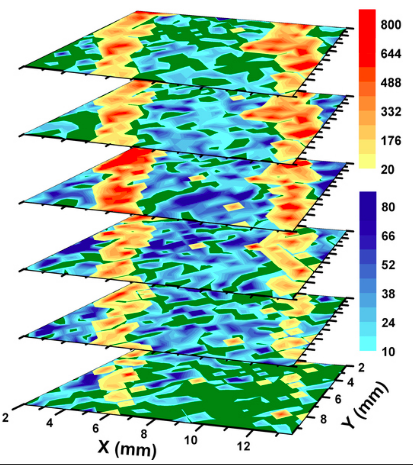LAESI provides very precise in situ chemical analysis of biological samples using mass spectrometry (MS) technique. LAESI enables 2D and 3D imaging of metabolites, lipids, peptides and proteins in biological samples at the single cell level, empowering rapid chemical analyses in multiple fields of biology, medicine and chemistry. The LAESI device embodies an ionization source / sample acquisition accessory to couple to standard mass spectrometers. LAESI uses the water naturally present within biological samples to absorb laser energy and ablate areas of interest with high spatial resolution. The laser can raster across a surface or drill down layer by layer. LAESI is compatible with any aqueous sample, like cells, tissues, blood, or urine. A major advantage is the lack of need for sample preparation and the absence of a chemical matrix that can skew MS analysis results. LAESI works at ambient temperature and pressure.
The original competitor in MS imaging, MALDI (matrix assisted laser desorption/ionization) requires a chemical matrix and a vacuum, both of which perturb biological samples leading to displacement and modification of molecules therein.
Desorption electrospray ionization (DESI) is a matrix-free competitor, but is not compatible with depth profiling and requires serial sectioning of samples to reconstruct 3D images.
Former GW licensee, Protea Biosciences Group, Inc., developed and commercialized a LAESI system. A mix of corporations, universities, and government labs (including Princeton University and the USDA) purchased LAESI instruments. Protea since decided to focus more on MS services than device sales. GW now seeks a new exclusive commercialization partner for LAESI devices and services.

Figure: Distributions of metabolites kempferol/luteolin (red scale) and chlorophyll a (blue scale) in a zebra plant leaf at multiple depths.
Applications:
- Quantitative analysis of molecules in solution, mixtures, cells, or tissues
- 2D & 3D molecular imaging of small molecules and lipids
Advantages:
- Sample prep eliminated or minimized
- Ambient conditions compatible with living samples
- No chemical matrix
- Excellent sensitivity and signal to noise ratio
- Single eukaryotic cell resolution
| Title |
App Type |
Country |
Patent No. |
File Date |
Issued Date |
Patent Status |
| Laser Ablation Electrospray Ionization (LAESI) for Atmospheric Pressure, In Vivo and Imaging Mass Spectrometry |
US Utility |
United States |
8,067,730 |
7/18/2008 |
11/29/2011 |
Issued |
| Three-Dimensional Molecular Imaging by Infrared Laser Ablation Electrospray Ionization Mass Spectrometry |
Continuation-In-Part |
United States |
7,964,843 |
11/25/2008 |
6/21/2011 |
Issued |
| Three-Dimensional Molecular Imaging by Infrared Laser Ablation Electrospray Ionization Mass Spectrometry |
US Continuation |
United States |
8,299,429 |
5/5/2011 |
10/30/2012 |
Issued |
| Laser Ablation Electrospray Ionization (LAESI) for Atmospheric Pressure, In Vivo and Imaging Mass Spectrometry |
US Continuation |
United States |
8,487,244 |
10/12/2011 |
7/16/2013 |
Issued |
| THREE-DIMENSIONAL MOLECULAR IMAGING BY INFRARED LASER ABLATION ELECTROSPRAY IONIZATION MASS SPECTROMETRY |
US Continuation |
United States |
8,487,246 |
7/27/2012 |
7/16/2013 |
Issued |
| Laser Ablation Electrospray Ionization (LAESI) for Atmospheric Pressure, In Vivo and Imaging Mass Spectrometry |
US Continuation |
United States |
8,809,774 |
3/12/2013 |
8/19/2014 |
Issued |